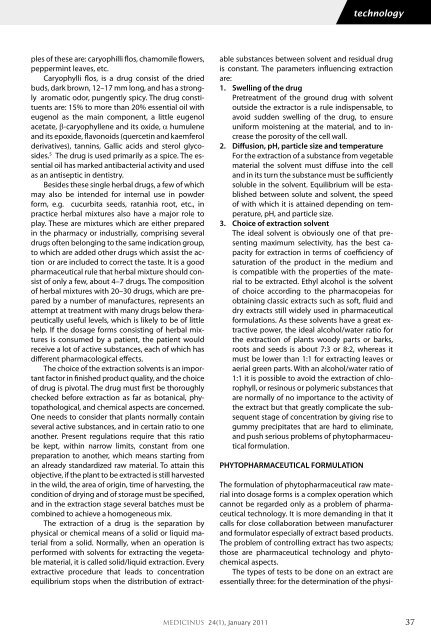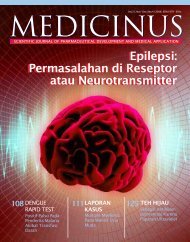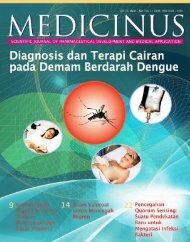Medicinus - Dexa Medica
Medicinus - Dexa Medica
Medicinus - Dexa Medica
You also want an ePaper? Increase the reach of your titles
YUMPU automatically turns print PDFs into web optimized ePapers that Google loves.
ples of these are: caryophilli flos, chamomile flowers,<br />
peppermint leaves, etc.<br />
Caryophylli flos, is a drug consist of the dried<br />
buds, dark brown, 12–17 mm long, and has a strongly<br />
aromatic odor, pungently spicy. The drug constituents<br />
are: 15% to more than 20% essential oil with<br />
eugenol as the main component, a little eugenol<br />
acetate, β-caryophyllene and its oxide, α humulene<br />
and its epoxide, flavonoids (quercetin and kaemferol<br />
derivatives), tannins, Gallic acids and sterol glycosides.<br />
5 The drug is used primarily as a spice. The essential<br />
oil has marked antibacterial activity and used<br />
as an antiseptic in dentistry.<br />
Besides these single herbal drugs, a few of which<br />
may also be intended for internal use in powder<br />
form, e.g. cucurbita seeds, ratanhia root, etc., in<br />
practice herbal mixtures also have a major role to<br />
play. These are mixtures which are either prepared<br />
in the pharmacy or industrially, comprising several<br />
drugs often belonging to the same indication group,<br />
to which are added other drugs which assist the action<br />
or are included to correct the taste. It is a good<br />
pharmaceutical rule that herbal mixture should consist<br />
of only a few, about 4–7 drugs. The composition<br />
of herbal mixtures with 20–30 drugs, which are prepared<br />
by a number of manufactures, represents an<br />
attempt at treatment with many drugs below therapeutically<br />
useful levels, which is likely to be of little<br />
help. If the dosage forms consisting of herbal mixtures<br />
is consumed by a patient, the patient would<br />
receive a lot of active substances, each of which has<br />
different pharmacological effects.<br />
The choice of the extraction solvents is an important<br />
factor in finished product quality, and the choice<br />
of drug is pivotal. The drug must first be thoroughly<br />
checked before extraction as far as botanical, phytopathological,<br />
and chemical aspects are concerned.<br />
One needs to consider that plants normally contain<br />
several active substances, and in certain ratio to one<br />
another. Present regulations require that this ratio<br />
be kept, within narrow limits, constant from one<br />
preparation to another, which means starting from<br />
an already standardized raw material. To attain this<br />
objective, if the plant to be extracted is still harvested<br />
in the wild, the area of origin, time of harvesting, the<br />
condition of drying and of storage must be specified,<br />
and in the extraction stage several batches must be<br />
combined to achieve a homogeneous mix.<br />
The extraction of a drug is the separation by<br />
physical or chemical means of a solid or liquid material<br />
from a solid. Normally, when an operation is<br />
performed with solvents for extracting the vegetable<br />
material, it is called solid/liquid extraction. Every<br />
extractive procedure that leads to concentration<br />
equilibrium stops when the distribution of extract-<br />
able substances between solvent and residual drug<br />
is constant. The parameters influencing extraction<br />
are:<br />
1. Swelling of the drug<br />
Pretreatment of the ground drug with solvent<br />
outside the extractor is a rule indispensable, to<br />
avoid sudden swelling of the drug, to ensure<br />
uniform moistening at the material, and to increase<br />
the porosity of the cell wall.<br />
2. Diffusion, pH, particle size and temperature<br />
For the extraction of a substance from vegetable<br />
material the solvent must diffuse into the cell<br />
and in its turn the substance must be sufficiently<br />
soluble in the solvent. Equilibrium will be established<br />
between solute and solvent, the speed<br />
of with which it is attained depending on temperature,<br />
pH, and particle size.<br />
3. Choice of extraction solvent<br />
The ideal solvent is obviously one of that presenting<br />
maximum selectivity, has the best capacity<br />
for extraction in terms of coefficiency of<br />
saturation of the product in the medium and<br />
is compatible with the properties of the material<br />
to be extracted. Ethyl alcohol is the solvent<br />
of choice according to the pharmacopeias for<br />
obtaining classic extracts such as soft, fluid and<br />
dry extracts still widely used in pharmaceutical<br />
formulations. As these solvents have a great extractive<br />
power, the ideal alcohol/water ratio for<br />
the extraction of plants woody parts or barks,<br />
roots and seeds is about 7:3 or 8:2, whereas it<br />
must be lower than 1:1 for extracting leaves or<br />
aerial green parts. With an alcohol/water ratio of<br />
1:1 it is possible to avoid the extraction of chlorophyll,<br />
or resinous or polymeric substances that<br />
are normally of no importance to the activity of<br />
the extract but that greatly complicate the subsequent<br />
stage of concentration by giving rise to<br />
gummy precipitates that are hard to eliminate,<br />
and push serious problems of phytopharmaceutical<br />
formulation.<br />
PHYTOPHARMACEUTICAL FORMULATION<br />
technology<br />
The formulation of phytopharmaceutical raw material<br />
into dosage forms is a complex operation which<br />
cannot be regarded only as a problem of pharmaceutical<br />
technology. It is more demanding in that it<br />
calls for close collaboration between manufacturer<br />
and formulator especially of extract based products.<br />
The problem of controlling extract has two aspects;<br />
those are pharmaceutical technology and phytochemical<br />
aspects.<br />
The types of tests to be done on an extract are<br />
essentially three: for the determination of the physi-<br />
MEDICINUS 24(1), January 2011 37




